This week we find out about bionic bodies. We discover whether it's possible to mend a broken heart with stem cells as well as investigate if soft nanobots could soon be delivering drugs around our bodies. We also bring you the highlights from this years British Science Festival. Plus, in Kitchen Science, we hit the kitchen to investigate one of natures composite materials - a chicken bone!
In this episode
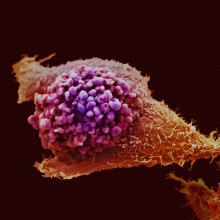
Prostate cancer infection link
There are a few cancers where we know that infection plays a part - such as cervical cancer, which is caused by HPV infection, or some cases of cancer caused by the Epstein Barr Virus. Now we may be able to add some cases of prostate cancer to that list, if early results from the US are anything to go by.Jennifer Stark and her colleagues have published results in the Journal of the National Cancer Institute showing a strong association between a common sexually transmitted infection, Trichomonas vaginalis, and risk of advanced and lethal prostate cancer in men.
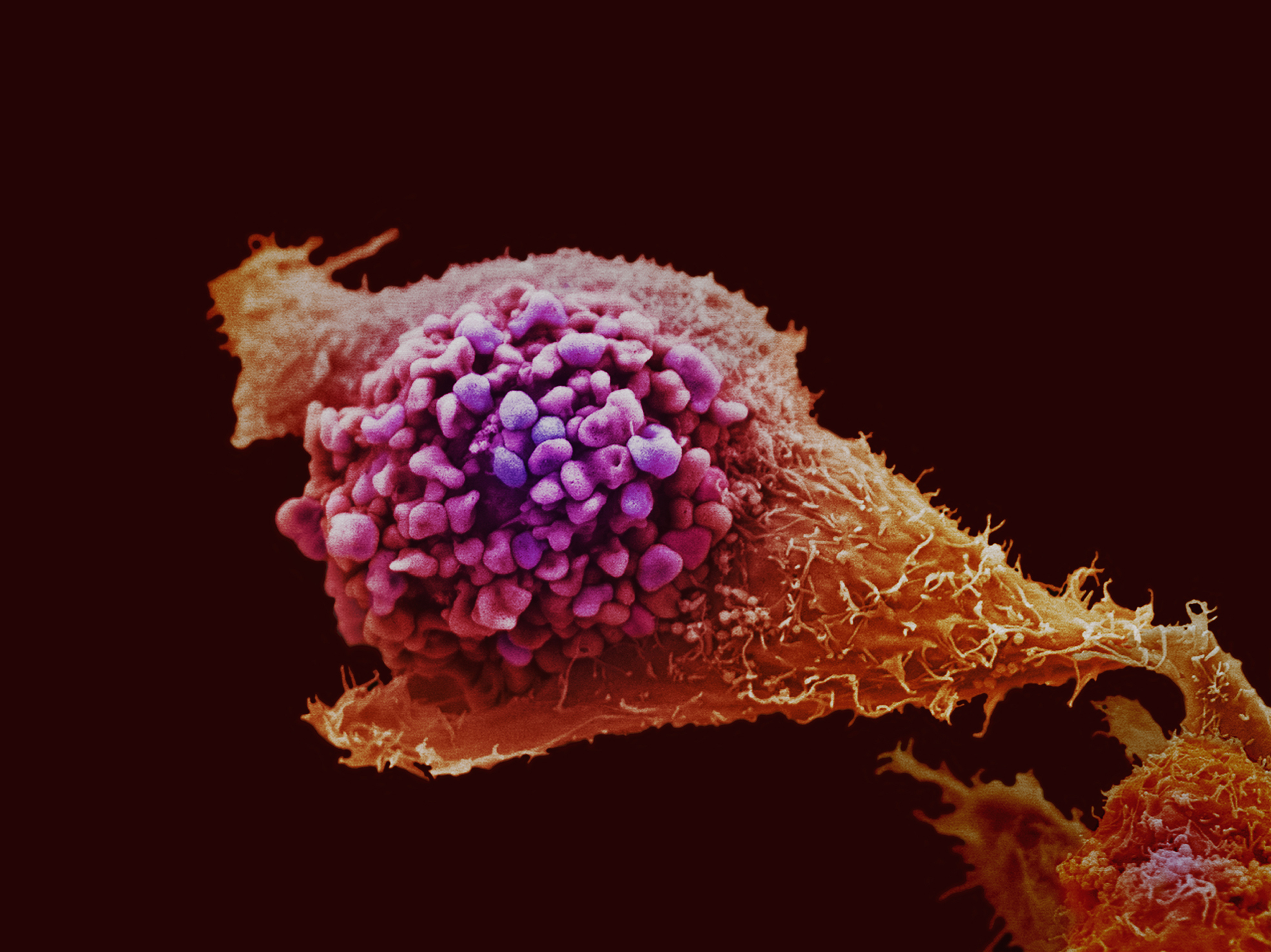 Trichomonas infects around 174
Trichomonas infects around 174 ![]() million people every year around the world, and can infect the prostate gland. It's thought that infection might cause inflammation, which in turn could trigger cancer. A previous study had found a link between prostate cancer risk and Trichomonas infection, but it was only small. This is a larger study of 673 men with prostate cancer. The researchers looked at blood samples, and compared their infection status with 673 men who didn't have cancer. The samples were taken back in 1982, before cancer had developed.
million people every year around the world, and can infect the prostate gland. It's thought that infection might cause inflammation, which in turn could trigger cancer. A previous study had found a link between prostate cancer risk and Trichomonas infection, but it was only small. This is a larger study of 673 men with prostate cancer. The researchers looked at blood samples, and compared their infection status with 673 men who didn't have cancer. The samples were taken back in 1982, before cancer had developed.
The researchers found that infection with Trichomonas was associated with a more than two-fold increase in the risk of advanced prostate cancer, and a nearly three-fold increase in prostate cancer that would result in death.
Unfortunately up to three quarters of men infected with Trichomonas may not realise they carry it, since they may not have any symptoms. And clearly, not everyone with the infection goes on to develop cancer. It's worth pointing out that much more work needs to be done to confirm this finding, and to find out how Trichomonas infection is exactly linked to prostate cancer. But if it holds true in larger studies, it would be an important finding, as infection is easily treated with antibiotics. Perhaps this will turn out to be a way to prevent many cases of prostate cancer every year.
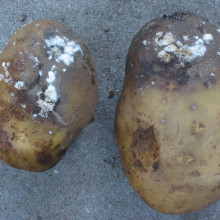
Genomic secrets of Potato Blight
The genome of the water mould responsible for Potato blight, and resultantly the great Irish famine, Phytophthora infestans, has been published in this week's Nature and there are some tantalising targets for attack.
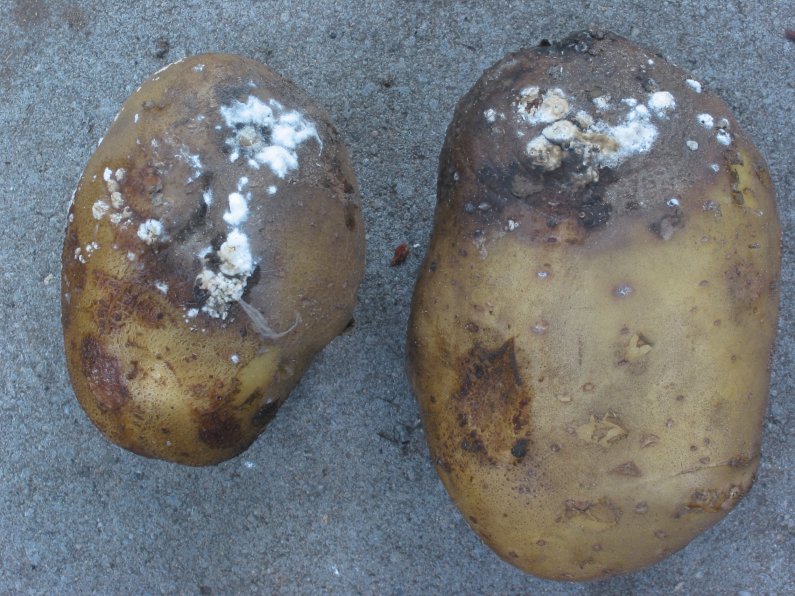 When we talk about the potato famine, which famously hit Ireland between 1845 and 1852, it seems like an historical, rather than contemporary concern. But plant diseases like potato blight remain a threat to food security worldwide - current annual losses due to blight are an estimated $6.7 billion.
When we talk about the potato famine, which famously hit Ireland between 1845 and 1852, it seems like an historical, rather than contemporary concern. But plant diseases like potato blight remain a threat to food security worldwide - current annual losses due to blight are an estimated $6.7 billion.
Preventing and treating blight has proven particularly difficult because it seems to adapt remarkably quickly to control methods, quickly taking hold in cultivars of potato that are, or rather were, genetically resistant to blight. Now, with the publication of its genome, we can start to understand just how it adapts so quickly, and devise better ways to fight it.
Chad Nusbaum, from the Broad Institute of MIT and Harvard, Cambridge, Massachusetts and colleagues from all over the world analysed the genome and compared it to other species of Phytopthora. They found a dense region of highly conserved genes, ones that the different species share, but the majority of the genome consisted of repeating regions.
This repetitive region of the genome was seen to contain genes that alter the normal biological processes in the plant, helping the blight to get past the plants defences. It also contained bits of DNA known to move around the genome, known as transposons, and this ability to alter the genome quite dramatically is thought to be a key feature in the rapid adaptability of the disease. Now that we know how it's doing it - we can start to identify targets for attack.
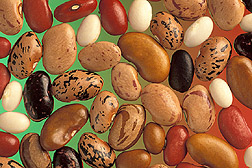 In a related paper in Current Biology this week, Dawn Arnold, from the university of the West of England, or UWE, reports on how the defences of the bean plant may be driving bacteria to become more pathogenic.Working with teams from Imperial College London & Reading University, the UWE researchers looked at Pseudamonas syringae, the bacteria that causes halo blight in bean plants. They observed that the bacterium, in response to the bean plant's defences, ejects a region of their DNA, or a Genomic Island, which is then taken up by other bacteria. This allows for horizontal gene transfer, which is thought to play a key role in the evolution of bacteria.
In a related paper in Current Biology this week, Dawn Arnold, from the university of the West of England, or UWE, reports on how the defences of the bean plant may be driving bacteria to become more pathogenic.Working with teams from Imperial College London & Reading University, the UWE researchers looked at Pseudamonas syringae, the bacteria that causes halo blight in bean plants. They observed that the bacterium, in response to the bean plant's defences, ejects a region of their DNA, or a Genomic Island, which is then taken up by other bacteria. This allows for horizontal gene transfer, which is thought to play a key role in the evolution of bacteria.
We know that bacteria can swap sections of their genome, and swapping of the pathogenic genomic island has been seen working in a few different ways in some pretty nasty characters - yersinia, which causes plague; the food poisoning bacteria salmonella and Vibrio cholerae, responsible for cholera. However, this is the first time that it's been seen to happen within a host, and seems to be encouraged by the stress of host immune attack.
Looking at the rest of the genome, they were able to identify genes that were essential to allow this gene transfer to occur. We may now be able to target these genes to help slow the development of pathogenicity and resistance in a range of bacteria, and make our disease control systems much longer lasting.
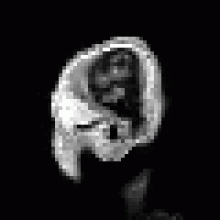
It's in there somewhere...
It has happened to us all at some point - a person looks familiar but you can't remember where on earth you met them. Now new research by neuroscientists in the states published in this week's edition of the journal Neuron suggests why - the memory does exist, but you just can't retrieve it.
Using functional MRI scanning, the scientists found that brain activity while remembering an event is very similar to when you first experienced it, even if you can't remember the details. But the researchers, led by Jeff Johnson, think that we could manage to access this missing details. So it could help us to boost our memory-power as we get older, and also help to shed light on vivid - but traumatic- memories that we may subconsciously forget.
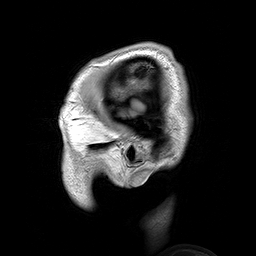 Inside a brain scanner, volunteers were shown words and asked to do various tasks. For example, this included imagining how an artist would draw the object named by the word, thinking about how the object is used, or pronouncing the word backward in their minds.
Inside a brain scanner, volunteers were shown words and asked to do various tasks. For example, this included imagining how an artist would draw the object named by the word, thinking about how the object is used, or pronouncing the word backward in their minds.
Then twenty minutes later, the volunteers saw the words a second time, and were told to remember anything linked to them.
By comparing the initial patterns of brain activity with the later patterns, the researchers were able to link certain patterns of brain activity to the different activities. When a volunteer strongly recalled a word from a particular task, the pattern was very similar to the one generated during the task. Also, when they only weakly recalled what they'd thought of, they still produced a pattern recognisable as belonging to that particular task.
So the results suggest our memory is in there somewhere - we just need to work out how to get it out!
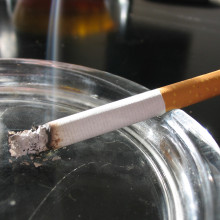
Addicted to Memories
Addictive drugs hijack a brain reward mechanism to strengthen drug-related memories and perpetuate drug use, according to a paper published in Neuron this week.
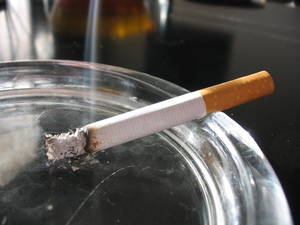 It's already known that dopamine, the brain's feel-good reward chemical, plays a role in addiction, and also participates in a process called synaptic potentiation - the strengthening of nerve connections that happens during learning.
It's already known that dopamine, the brain's feel-good reward chemical, plays a role in addiction, and also participates in a process called synaptic potentiation - the strengthening of nerve connections that happens during learning.
To find out if dopamine would encourage synaptic potentiation as a result of exposure to drugs, John Dani from the Baylor College of Medicine in Houston, Texas, and colleagues gave physiologically significant doses of nicotine to freely moving mice while recording brain activity.
They noticed increased synaptic potentiation that correlated with the mice learning to prefer a location that was associated with the nicotine dose. They also recorded a local dopamine signal in the hippocampus, a region towards the centre of the brain that is critical for the formation of new memories, reinforcing the view that dopamine enables memories of specific events to be formed.
This starts a vicious cycle, where dopamine strengthens drug associated memories and thus attaches more importance to them, and increases the likelihood of future drug use. In any normal situation, this dopamine signal would mark memories and feelings about the environment as important, and this would mark an important part of the learning process, but in the presence of an addictive substance, the system is subverted.
John Dani summarised the importance of this for understanding addiction:"When specific environmental events occur, such as the place or people associated with drug use, they are capable of cuing drug-associated memories or feelings that motivate continued drug use or relapse." Understanding how drugs change our perception may help to develop treatments or means to prevent relapse, saving both money and lives.
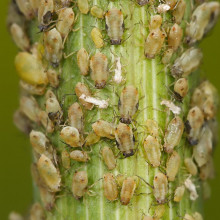
14:50 - Aphids and Pesticides
Aphids and Pesticides
with Professor Lin Field & Professor Kim Hammond-Kosak, Rothamsted Research
Ben - Also in the news this week - an international consortium of Aphid researchers have been studying the newly decoded aphid genome, due to be published later this year, with a view to developing better pesticides that will not let the aphids develop resistance. Diana O'Carroll met Professor Lin Field and Professor Kim Hammond-Kosak at the British Science Festival to find out why the aphid, and pesticide resistance, is such a problem...
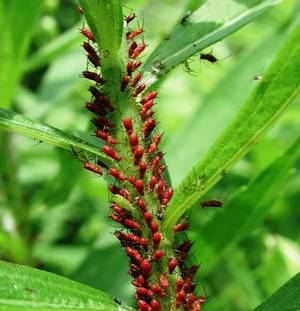 Lin - The problem is that we need to control insect pests so, insects are pests of many of our crops and if we didn't control them, we would have a severe reduction in crop production, and at the moment when all the emphasis is on trying to grow more food, we need to make sure we can control pests effectively. The trouble is that when you control pests with chemistry for instance, the pests are kind of one jump ahead of you at some point and they develop a resistance to those chemicals and we have to find ways of either overcoming that resistance or managing it or designing better pesticides that will overcome resistance and also be more selective for pest insects rather than beneficial insects.
Lin - The problem is that we need to control insect pests so, insects are pests of many of our crops and if we didn't control them, we would have a severe reduction in crop production, and at the moment when all the emphasis is on trying to grow more food, we need to make sure we can control pests effectively. The trouble is that when you control pests with chemistry for instance, the pests are kind of one jump ahead of you at some point and they develop a resistance to those chemicals and we have to find ways of either overcoming that resistance or managing it or designing better pesticides that will overcome resistance and also be more selective for pest insects rather than beneficial insects.
Diana - Lin, we've got some species of some little aphids there, I think. Could you quickly give us a talk through them?
Lin - Yes, I can. Aphids are a very important crop pest mainly, because they carry various diseases- plant viruses. They can do some direct damage by feeding on young shoots but the most damage is done by vectoring viruses. And one of the most important pests is this aphid, the 'peach potato aphid' or Myzus persicae, to give its Latin name. This is a very important pest in the UK of potatoes, sugar beet, oilseed rape and we have quite a lot of problems with this aphid because it's developed a resistance to many chemicals. This other aphid here is actually the pea aphid or Acyrthosiphon pisum. And the reason I've brought that along is not because it's a very important pest but because this is the aphid where we now have a genome sequence. So we have a full genome sequence for this aphid and most of the genes in there seem to be very similar to genes in other aphids, and we are now able to use that information to look at the genes and the proteins involved in insecticide binding and try to devise ideas about making better chemicals to overcome resistance or perhaps to bind to the target protein in this aphid rather than in a beneficial like a bee. So, having the genome of this aphid is now helping us with new control measures for other aphids.
Diana - And Kim, just to come to you, could you explain a little bit more about how sequencing the genome can help us find those targets?
Kim - Yes, I mean, when you sequence a genome, first of all, you end up with just a long string of A's, C's, T's and G's. But it's when you actually look at that in the context of the genes and where the genes are situated in the genome then some patterns start to emerge-what genes are present, what are absent, which ones are different between the species, and then you can actually say to yourself, does this actually then affect the biology of the organism? Because our different pests and pathogens have different strategies to attack and cause disease and damage to plants, and then you can start to say that there might be some correlations between the presence of particular genes and the way in which they actually have the strategy of attack.
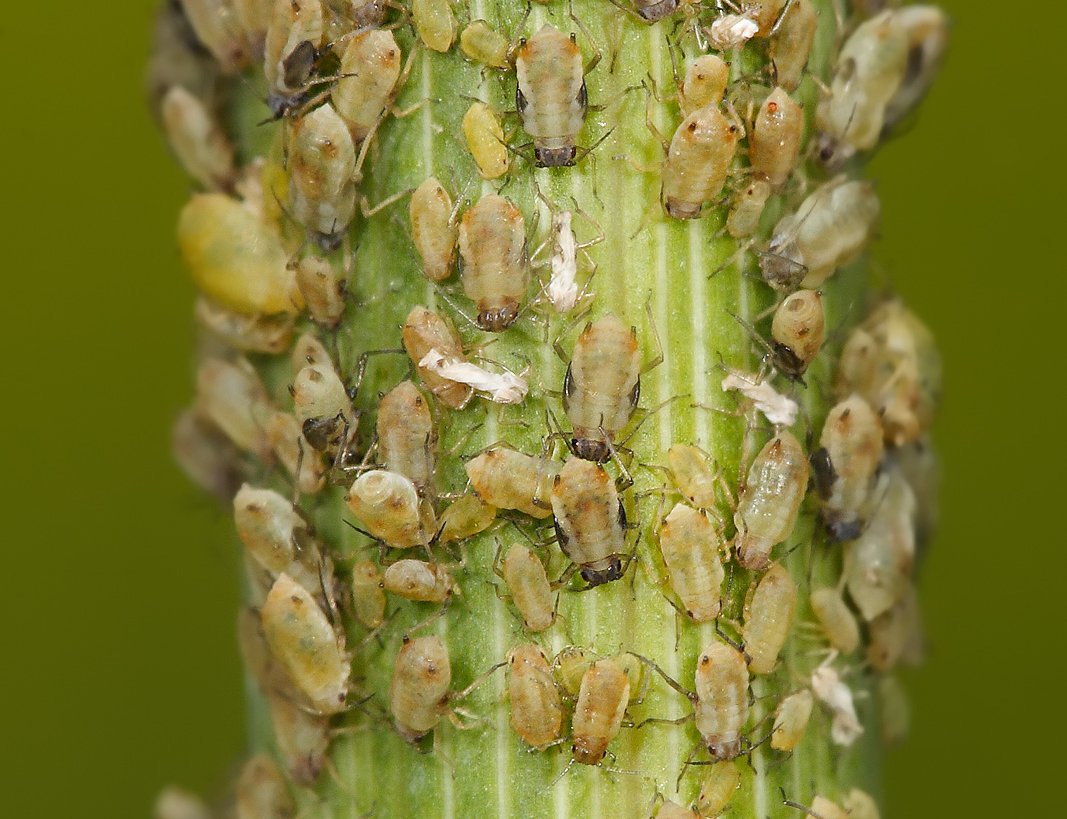 Diana - Do you think that finding these targets will be the solution?
Diana - Do you think that finding these targets will be the solution?
Kim - I don't think there'll ever be a final solution. It means that you're almost on a staircase and what you do is, you successfully hop up each step and then it gives you a chance of actually controlling what is going on at the moment, learn from the mistakes, benefit from the gains, and then hopefully move to the next step when you've got more information and by sequencing, particularly in the failures, the strains that come through, what is selected each time and then learning from those.
Lin - And, I think for insects, the benefit of having genomes from a whole different range of different insect species which we're now beginning to get, it's going to allow us to look at the use of chemicals that will target one species because one of the problems with using insecticide has been that the use of it in crop pests has spilled over into damage to non-target pest, which is what we want to avoid.
Ben - That was Kim Hammond-Kosak and Lin Field from Rothamsted Research explaining how understanding the genome of an insect pest can help to develop new control methods that get around the problem of pesticide resistance.
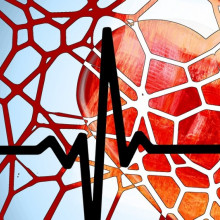
18:45 - Mending a Broken Heart
Mending a Broken Heart
with Sian Harding, National Heart and Lung Institute, Imperial College
Sian Harding is a Professor of Cardiac Pharmacology at the National Heart and Lung Institute at Imperial College, London and she's here in the studio with me now. Now, Sian has been using stem cells to develop cardiac patches that could hopefully, one day, be placed on to damaged tissue damaged by a heart attack and basically send in the special cells to repair it. Hello, Sian, thank you ever so much for joining us...
Sian - Hello, Ben. Hi!
Ben - Now, cardiac repair sounds an incredible ideal that's something that we would obviously want to do. Heart disease is a very common killer. What are the problems at the moment with cardiac repair?
Sian - Well, first of all, I should say that there are trials, clinical trials, have been going on for some time using stem cells for cardiac repair and with some success as well. They've been using bone marrow cells and injecting these into peoples' hearts. And I think probably 400 or 500 people have been treated that way. There's one going on in London now with John Martin and good things have happened with these but what appears to be happening is, if anything, a re-growth of blood vessels into the area. But what appears not to be happening is a production of new actual beating muscle, the myocytes, the muscle cells of the heart. So this is one of the problems and this is what we've been trying to look at in more detail along with any other people about what's the best cell to produce a myocyte.
Ben - So, although these new blood vessels are obviously a good thing: it'll help to keep heart oxygenated it'll help to keep the muscle that is there healthy. It obviously won't mean that we can grow back, that we can actually regenerate heart tissue.
Sian - That's right. The capacity for the heart to regenerate itself even with these new blood vessels is really very low, especially as you get to the older ages.
Ben - So, where do you think is the best source for stem cells, if the bone marrow isn't quite doing what we need to do, isn't doing the full job? What should we be looking at?
Sian - Well, the frontrunners, the ones that are really good at producing, contracting myocytes at the moment are the human embryonic stem cells and we have used these to produce beating muscle. It's a very tough muscle. We've kept it in the laboratory beating for over a year in some cases. You can send it through the post. It will come out beating at the end. It's really good tough stuff. Now, I mean there are problems with this - some people have worried about the ethical problems. It certainly is a problem about matching it to the immune system of the person. So there are other possibilities. One thing is the induced pluripotent cells by looking at what makes an embryonic stem cell an embryonic stem cell. People have put those factors into skin cells and produced some cells that are really quite like embryonic stem cells and then there are adult stem cells that you can harvest from the heart and expand. And all these are like coming up on the outside and could be very good but at the moment, they're just potential; whereas the embryonic stem cells are all the ones that are producing the most healthy and hearty tissue at the moment.
Ben - It does seem that this is a field of great expansion, an awful lot of new interesting discoveries at the moment because there's a story only a couple of weeks ago about how we might be able to induce stem cells to come out of the waste from liposuction, from just human fat.
Sian - Oh, yes and I'd be among many other ladies who are very happy with it. The idea of this source of repair, certainly yes. So there are lots of other stem cell sources. Now, the problem we have is that if you have made a cell into a beating heart cell is getting it to the heart. You can't put it down the blood vessels like you could for bone marrow cells because now they're too large, just block up the blood vessels. So you have to find another way to do it. And if you inject it into the heart, I think if anybody's ever seen a heart contract, you can see exactly what's going to happen. You put a needle in, you inject your substance, your cells, the heart contracts and squeezes it right back at you so you lose a lot of your cells that way.
Ben - Yes, I'd imagine that could be quite messy. So you have come up with a slightly more elegant solution of using patches.
Sian - That's right. So we want to get some kind of ready-made patch to put to transfer the cells into place. Most likely, over the scar that happens when you have the heart attack, the infarct scar. So that's the best place to put it and really now, the interesting part is thinking about what's the best way to get the cells there. There are natural materials that have sort of porous structure that cells can grow into. They're one good thing. But at Imperial College, we have this fantastic materials department and so, we've been trying to make some polymers that have perhaps some added benefits. For example, one thing we're trying to do is make our polymer match the sort of contractile elastic properties of the heart so it can stop the scar from ballooning out and expanding so you can produce some extra benefit. While the cells are getting into place and getting ready and growing, you can keep the heart from getting any worse during that time.
Ben - And would you also be able to, as well as attaching your stem cells, can you attach all the different factors that you might need to encourage them to really become part of the existing heart tissue and to develop properly?
Sian - That's right and one of the benefits of the polymers again or even some hydro gels is to allow slow release of these kind of factors. For example, factors to encourage blood vessels to grow into the cell patch that you've put on or factors to protect the cells. Because if you the patch on when the heart attack has just happened, it's a very hostile environment, very inflamed so you need some kind of inhibitors of that inflammation to protect them. So even though they are tough, you need something to protect them.
Ben - It's always nice to hear of a scientific endeavour that is so multi-departmental and you have the material scientists and, obviously, you'll have people working on the medicine side but how-once you've made a patch, how is it actually delivered? I assume you don't need to be quite as invasive as you would do if you're fully opening up the heart.
Sian - Well, in this case at the moment, we are looking at opening up the heart because you need to put it on top of, underneath the pericardium that wraps around the heart. There are a lot of robotic technologies being developed at Imperial, which have potential for later on. They're putting amazing things like valves even by robotic technologies. So there's the potential there, but at the moment, we would need an open-heart surgery.
Ben - Well, clearly, this is relatively early days. Where abouts are we at the moment, how far do you think it's going to be before we can really start looking at putting these into people and seeing them actually working out in people on the street.
Sian - Well, there are parts of this puzzle that have already got into the clinic or have been approved for clinical use. There's a patch of fibroblasts that can be put on the heart that's been approved. The human embryonic stem cells have been approved to go into a trial for brain so that's there and so the polymers that we're using are derivatives of ones that are used in other kinds of tissue engineering solutions that have already been put into the body in some form or other. So, out there, the parts of the puzzle are just getting into the clinic. It's putting it all together is what we need to do now.
Ben - Well, this sounds incredibly promising. It must be a very exciting field to work on as well.
Sian - Oh, extremely exciting. There's a new thing for stem cells to do every week, a new way of getting them more things that they can make, yeah.
Ben - Fantastic. Well, thank you ever so much for joining us. That was Sian Harding from the National Heart and Lung Institute, Imperial College, London.

27:38 - British Science Festival 2009
British Science Festival 2009
with Stuart Haszeldine, University of Edinburgh; Kerry Kirwan, University of Warwick; Andy Stamford-Clark, IBM, UK; Tony Little, University of Stirling; Jeremy Spencer, University of Reading;
Diana - This year's British Science Festival has seen a bevy of scientists descend upon the University of Surrey to talk about their findings and experiments, some more unusual than others. And if anyone had trouble paying attention to all these talks, it seems the answer comes in the form of flavonoid-rich blueberries. Jeremy Spencer from the University of Reading has found that a dose of blueberries can help maintain your attention span for to up to five hours.
Jeremy - We took a group of younger individuals and older individuals and we brought them to the University of Reading and we gave them a controlled breakfast then we performed the series of cognitive tasks, which measured things like short-term memory, attention and motor performance, and then we gave them a blueberry smoothie, if you like, 200 grams of blueberry ground up. One hour after that, they performed a cognitive task again and then again after five hours. What we found was, over the five-hour period we had deterioration on the control group. Their attention was found to drop over the five-hour period whereas for the ones who were taking the blueberry attention remained high. In other intervention studies, it certainly seems that blood flow to the brain is involved in these processes.
Diana - They think that flavonoid-rich foods serve to dilate the blood vessels and increase blood flow to the brain thereby improving attention spans. Jeremy Spencer, University of Reading. Something most of us will pay attention to is a good-looking person. But what is it that makes one person more attractive  than another? A number of studies have looked at symmetry and youthfulness but Tony Little at the University of Stirling thinks it also has something to do with the company you keep.
than another? A number of studies have looked at symmetry and youthfulness but Tony Little at the University of Stirling thinks it also has something to do with the company you keep.
Tony - We've also been studying copying-like effects whereby people are kind of taking information from other people's mate choice decisions and from that, we found that if you pair someone with an attractive partner then that increases their attractiveness and if you pair them with an unattractive partner, that decreases their attractiveness. So yes, I think when you see Hugh Heffner, he might not be the most attractive man but if you see him with his Playboy beauties then perhaps you can infer that there's something good about him like having money or perhaps he's personally very nice and pleasant.
Diana - Hugh Heffner: possibly pleasant. Tony Little from the University of Stirling. Also at the festival this year, were some attractive developments in technology. One such modification to everyday objects created an intelligent home for Andy Stamford-Clark.
 Andy - So, I've got my house linked up to various sensors to monitor things that are happening like whether the windows are open, how much power are we are using, how many litres of water we've used during the day and things like that. But when I discovered Twitter a couple of years ago, I thought it would be quite cool to link objects to Twitter so Tweetjects objects that Twitter. And so, I built a gateway from the messaging system through to Twitter which means that anything that's used in my house basically, can now make up a Twitter message and send it out to the Twitterverse, which talks about things like five pounds' worth of electricity used so far this month or 100 litres of water used so far today or the phone's ringing. So, the main thing has been the power saving. I've reduced my electricity bill by about a third in the year since I've been using it, which is several hundred pounds back in my pocket, which is very nice. It saved us once from wasting a lot of water. I got three texts in a row on my phone from Twitter saying 100 litres used, 200 litres used, 300 litres used and I quickly stopped the car and phoned my wife and said, "What's happening?" Have we got a flood. And she looked out the window and saw the nozzle had flown off the end of the hose pipe, and it was just pumping water into the garden so that saved us wasting a whole lot of water which, as we're on the Isle of Wight, we're metered so that would've cost us money and of course it's a valuable resource so that was a good thing.
Andy - So, I've got my house linked up to various sensors to monitor things that are happening like whether the windows are open, how much power are we are using, how many litres of water we've used during the day and things like that. But when I discovered Twitter a couple of years ago, I thought it would be quite cool to link objects to Twitter so Tweetjects objects that Twitter. And so, I built a gateway from the messaging system through to Twitter which means that anything that's used in my house basically, can now make up a Twitter message and send it out to the Twitterverse, which talks about things like five pounds' worth of electricity used so far this month or 100 litres of water used so far today or the phone's ringing. So, the main thing has been the power saving. I've reduced my electricity bill by about a third in the year since I've been using it, which is several hundred pounds back in my pocket, which is very nice. It saved us once from wasting a lot of water. I got three texts in a row on my phone from Twitter saying 100 litres used, 200 litres used, 300 litres used and I quickly stopped the car and phoned my wife and said, "What's happening?" Have we got a flood. And she looked out the window and saw the nozzle had flown off the end of the hose pipe, and it was just pumping water into the garden so that saved us wasting a whole lot of water which, as we're on the Isle of Wight, we're metered so that would've cost us money and of course it's a valuable resource so that was a good thing.
Diana - A home that Twitters, Andy Stanford-Clark from IBM, UK. Another creation with environmental considerations was the "Worldf3rst" part-recycled Formula 3 car. Formula racers tend to conjure up images of enormous budgets, exploding champagne bottles and general indulgence but Kerry Kirwan from the University of Warwick is taking a slightly different approach with his car made out of, among other things, beetroot and carrots.
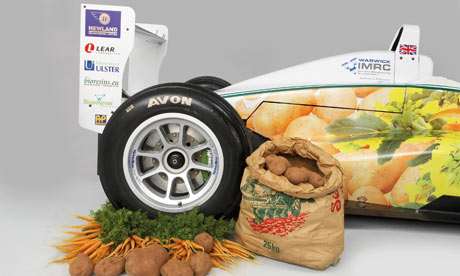 Kerry - Well, the "Worldf3rst" Formula 3 car has a whole raft of environmentally friendly technologies on it so it's made from recycled materials or waste materials and then some natural materials. It has a carrot-fibre steering wheel. It runs on bio-diesels brewed from waste chocolate and waste alcohol, and it's got natural fibre composite panels on it. It's got recycled carbon fibre panels on. It's lubricated by vegetable oils and it also has a catalyst that converts low-level ozone to oxygen as you're driving along so it helps to cancel out smog and things.
Kerry - Well, the "Worldf3rst" Formula 3 car has a whole raft of environmentally friendly technologies on it so it's made from recycled materials or waste materials and then some natural materials. It has a carrot-fibre steering wheel. It runs on bio-diesels brewed from waste chocolate and waste alcohol, and it's got natural fibre composite panels on it. It's got recycled carbon fibre panels on. It's lubricated by vegetable oils and it also has a catalyst that converts low-level ozone to oxygen as you're driving along so it helps to cancel out smog and things.
Diana - And when's the next outing? Can we see her in action anytime soon?
Kerry - We hope she's going to be running for her first competitive race in October at Brands Hatch and she's already done the Goodwood Festival of Speed and done the hill climb there a half dozen times and was very fast and a great crowd pleaser so it has given us comfort that she could do well in a Formula 3 race.
Diana - I think that counts as one of your five-a-day. Kerry Kirwan from the University of Warwick. Now, even Kerry's car will pump out some carbon dioxide during manufacture and the race itself but there are ways of recapturing carbon after it has been emitted. One method involves pumping carbon dioxide into underground cave systems and porous rocks. And Stuart Haszeldine from the University of Edinburgh has found that the UK is particularly well-placed to do this.
Stuart - So it looks like 95% of the storage available is in saltwater aquafers, the other 5% is in depleted oil fields and in depleted gas fields. That storage could take several hundred years of UK emissions from power stations and what we're promoting is that could actually take 100 years of power station emissions from all of Northwest Europe instead of putting the next hundred years of carbon dioxide into the atmosphere from Germany and Denmark and Belgium and Holland and Poland. Instead, we could build a large set of pipelines and inject that deep beneath the North Sea and the UK could charge a rent for that and make money out of that.
Diana - Carbon storage for sale and that was Stuart Haszeldine from the University of Edinburgh. And although storage capacity is finite, it might give us a bit more time to get around to replacing our bulbs or decide what we want to do about bio-fuels or nuclear power or wind farms or hydrogen fuel cells and oh, everything else.
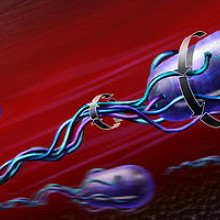
34:35 - Nanobots to the Rescue
Nanobots to the Rescue
with Professor Tony Ryan, Sheffield University
Kat - Now, we've covered all sorts of nanotechnology on our show before and an exciting new area is so-called "Soft Nanotechnology", or is it all that new? The cells in our bodies are fantastic examples of soft machines that work at the nanoscale and now scientists are attempting to copy some of that cell technology to build mini machines of their own. Now we're joined by Professor Tony Ryan from Sheffield University. He's one such scientist. Hello, Tony.
Tony - Hello, Kat.
Kat - Hello. So what exactly do we mean when we talk about soft nanotechnology?
Tony - It was great in the introduction when you said we learn from biology and from cell biology in particular because I'm a physical chemist and I've drawn my inspiration for this research and my colleague Richard Jones, basically from cell biology books. So cells, all the cells in your body are put together by a process called self-assembly and that's where the molecules have information written into them to form structures whether they be membranes or little machines and the self-assembly is done by the molecules wiggling around, under the control of or not under the control of, by Brownian motion. So, soft nanotechnology uses self-assembly with molecules that contain information and Brownian motion to build structures just like biology does.
Kat - So would this be like proteins that kind of fold under their own steam. They've got the right kind of bonds in them that make them work?
Tony - If only we were that clever. Proteins have 21 building blocks and fantastic sequence and actually most of a proteins there, if a protein's a thousand units long, most of a proteins there to hold four or five units in a specific configuration and that's really, really hard to predict ab inicio so we make much simpler molecules with maybe, one or two or three different units, where we can program pattern formation and structures.
Kat - And are you using things based on amino acids, based on the sort of things that we see in nature?
Tony - So in our research, we've particularly tried to not use anything natural, okay? So what we're trying to learn are the design principles. So we've used more or less extensively synthetic polymers. So we make our own molecules that show some of the features of proteins but they're completely and utterly synthetic then we don't have this kind of Frankenstein fear of the grey goo taking over the world and things.
Kat - And how small are we actually talking? What sort of size can you go down to?
Tony - Well, so we can exercise control at the level of molecules at the nanometre level, that so it really is nanotechnology.
Kat - And what sort of things are you using these for? What sort of applications do you think they could have? 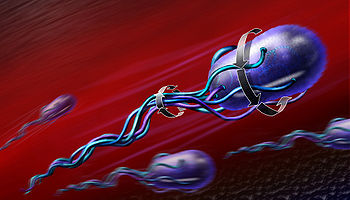
Tony - Well, I was out with some neuroscientists earlier this week and we were discussing delivering molecules across the blood-brain barrier, which is a particularly hard thing to do. You know, the enduring image of nanotechnology is of this miniature submarine that swims around in your body, you know, a bit like the Fantastic Voyage. And it's a very appealing movie and it's got Raquel Welch in a scuba diving suit and things, but that really wouldn't work. All the physics of how things happen at the level of cells, below the micron scale, mean that materials and objects behave very differently. So, a miniature submarine wouldn't work but something that looks like a bacteria or a sperm might work to do that job of cell-by-cell delivery.
Kat - Excellent. So we could say, deliver drugs across the blood-brain barrier or maybe specifically into tumours or something like that?
Tony - Well, tumours are actually, relatively easy so...
Kat - They love nanoparticles.
Tony - Well, they do but that's because the blood supply to tumours is generally very, very leaky. So if you put something in the blood supply then it will fall out of the blood supply where there are holes and generally there are holes around tumours so to address something to a tumour is actually done now. You can get things called stealth liposomes, okay? So they're liposomes just like a famous cosmetics company might try and sell you, because you're worth it. So this is a bag that's decorated with molecules that stop the immune system attacking it and then that bag comes out of the blood supply around a tumour and just naturally collects there and that's used to deliver doxorubicin in the clinic now.
Kat - Yeah because liposomes are another example of something that just sort of assembles itself if you get the water and the fat right, isn't it?
Tony - Yup. So our molecules basically learn from liposomes. So we learn from lipids how to make a membrane. So what we've been doing is making molecules. They're called blocko polymers. So if you think of the polymer as a piece of string, then we have a piece of string that maybe red one side and blue the other, and the red bits have water and the blue bits love it. So it makes a bi-layer so all the red bits cluster together and the blue bits protect them from the water and then they make a big sheet and the sheet wraps up to make a bag. And then as you wrap the sheets up, you can put things in the bag, okay? And these bags will float around and we've even designed them so that if they get taken into a cell, they go into a thing called an endosome and the endosome changes the pH and then the changing pH makes the bag explode.
Kat - Ah, very clever.
Tony - And deliver the contents and we've used that to transfect, actually to do gene therapy to make green fluorescent protein in a whole range of human and animal cells. And now the thing is, can we attach a little tail to one of these bags to make it swim?
Can the heart develop cancer?
We put this question to Professor Sian Harding:Sian - It's very rare to get cancer of the heart. And if you do get it, it's usually cancer of the blood vessels in the heart angiosarcoma rather than the muscle cells of the heart itself. And in a sense, cancer and heart disease are two ends of the spectrum with cancer being very fast-growing cells whereas; heart disease is because the heart can't regenerate itself very much. And one of the things that we have to be really careful about in stem cell research for heart disease is not doing things to trigger cancers. If there were things that we might want to do for the heart like growing more blood vessels or stimulating stem cells, or reducing the amount of natural cell death are all the opposite things to what the cancer people want to do to kill off the cancers. So we have to be really careful in treading that line.Ben - And Kat, is heart cancer something you come across often in your day job (at Cancer Research UK)?Kat - Yeah. There's a bit of a myth that the heart is something that doesn't get cancer but it can happen, and as Sian says incredibly rare and it is because the heart doesn't regenerate. It doesn't turnover its cells whereas tissues like breast, bowel, skin, they tend to make new cells a lot so you just increase your chances of getting cancer in those tissues. But it can happen though it is phenomenally rare.
Can you repair the mind?
Kat - I think it should be possible. There's certainly some evidence that I think anti-depressant drugs can change the turnover of cells. It would be interesting to see if Sian's got any views on this.Sian - Yeah. That's certainly true that depression reduces the turnover of cells in the brain. So certainly from that point of view, the regeneration might have a possibility and things like repairing the pathways that are changed in epilepsy, you could see that would be very amenable to this kind of stem cell regeneration.
Do we all see colours as the same?
Ben - I think it's partly cultural but ultimately, the actual frequency of light that our eyes are picking up is going to be same for green as it is for everybody else. But then if we're brought up being told that green is in fact blue then, we'll always going to think that green is blue. Kat, what do you think?Kat - Yeah. I think we had someone on a while ago who was talking about the science of vision and basically the red I see is not the same as the red you see. It's because the frequency maybe the same but it really depends how the brain interprets it.
Can colourblind people play cricket?
Kat - I think you would still see the motion of the ball and you'd still see the ball. You just might not see the colour of it.Ben - It has a very different texture to grass, of course.Kat - Yeah.Ben - And on the forum, there was quite a bit of a chat about this Lyner, RD and Bored Chemist all making very good points about it and Bored Chemist pointed out of course that blind people also play cricket. So whether or not you can actually see the ball may not necessarily be a hindrance when playing cricket. But if you are colour blind and if you'd like to let us know how you cope with playing cricket then please do get in touch. You can drop us an email to chris@thenakedscientists.com.

53:44 - What dictates the frequency of waves?
What dictates the frequency of waves?
We put this question to Stephen Salter, retired Professor of Engineering Design at Edinburgh University...
The frequency of ocean waves depends on the wind speed, the time that the wind has been blowing and the length of the sea that it is been blowing over, which is what we call the fetch.
We actually prefer to talk about the period of waves, which is the inverse of frequency because people like to think about numbers greater than one rather than thinking about small decimals.
If you started with the wind blowing over calm water, the waves start with small heights and short lengths but these steadily increase.
In deep waters, the waves with the longer lengths travel more rapidly and the growth continues until the speed of the waves is about the same as the speed of the wind when it can't put any more energy in. And we describe this as a fully-developed sea.
There's actually been a mixture of periods and people are quarrelling about how you define the period in the mixture of them.
Real seas often have a spectrum with more than one peak, showing that the waves are coming from more than one place, or maybe that the wind speed changed while they were growing. Periods in seconds of the same sort of order as wind speeds measured in metres per second, a bit more or a bit less depending on how you define your period.
And most sea waves have periods in the range of 5 to 15 seconds with the longer ones coming when you had a really fast wind blowing for a long time over a long bit of sea...










Comments
Add a comment